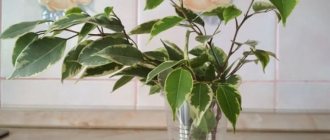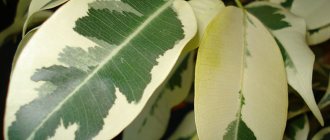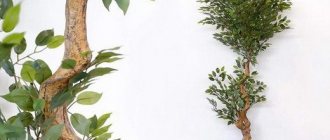Ficus benjamina came to us from tropical regions; this evergreen tree bears on its short trunk with smooth gray-beige bark a widely branched crown, which is supported by numerous aerial roots. There are garden forms of Ficus Benjamin, including small-leaved trees. Ficus benjamina, known to many as a houseplant, does not require special care and is quite suitable as a bonsai. Read about the features of growing Ficus Benjamin indoors in our article.
Variegated Ficus benjamina
History of the origin of the plant
Ficus is a plant of the mulberry family (Moraceae) , which, by the way, also includes the fig tree with edible fruits.
The plant's homeland is Eastern India, but information in this regard is ambiguous.
The homeland of the ficus is called southeast Asia and northern Australia. In nature, it is a tall tree with a wide crown and flowing branches.
However, in indoor conditions, this weeping tree rarely exceeds 2.4 m in height, although specimens up to 3 m are found.
Ficus Benjamin: crown formation and regular pruning
Young shoots of Ficus Benjamin are characterized by a high growth rate and are very flexible. The first circumstance obliges the owner of the flower to master regular pruning. It is performed in the spring, when the plant is just awakening to growth. In the summer, fast-growing shoots that are out of sync with the general rhythm are pinched. At the end of the growing season, in the fall, it is not worth exposing Ficus Benjamin to crown formation. All the substances contained in the leaves and shoots will be useful to him during the winter.
The crop easily tolerates pruning of branches, so there is no need to be afraid of a radical change in the appearance of the plant while it is young. It will be much more difficult to form a ficus crown when it turns into a shapeless giant.
In the spring, not only the dried branches are removed and the excessively elongated branches are shortened, but also the branches directed into the crown are pruned. If this is not done, they will prevent the penetration of air, which will increase the risk of developing fungal infections and the spread of pests. For the same purpose, large sections of branches are treated with garden pitch or activated carbon powder.
A video about pruning Ficus Benjamin at home will tell you in detail how to perform this difficult procedure and achieve uniform growth of branches throughout the growing season.
Home care
Ficus benjamina variegated is more whimsical than its fellows.
It grows quite quickly, but requires a lot of light.
It can even live in a spacious, well-lit kitchen.
Considered easy to grow.
If a new tenant has appeared in your house named ficus benjamina with variegated leaves, then immediately decide on the place of his permanent residence.
He really doesn’t like to change the situation!
You need to know the following rules for its habitat:
- maximum lighting;
- protection from direct sunlight;
- away from heating radiators;
- no drafts.
From the first day you can spray the plant up to 2 times a day.
Important: You can replant only after a little adaptation, about three weeks.
Watering
It needs spraying both in summer and winter. Places high demands on the degree of humidity.
Therefore, in winter you need to keep away from heating radiators and use daily spraying.
For irrigation, soft, settled, warm water is used.
In summer, abundant watering is required. Approximately twice a week.
However, you need to make sure that the soil is slightly dry.
Important: The roots should not get wet in water.
In winter, watering is moderate, approximately once every ten days.
They don't need a lot of moisture in winter. From its excess, the lower leaves will fall off and the plant will lose its decorative appearance.
Tip: Once every two weeks, it is recommended to apply liquid organic or mineral fertilizers along with watering.
Bloom
A fact little known to many, but indisputable: the ficus flower is an inflorescence called syconia.
They look more like berries than flowers.
True, they do not bloom in indoor conditions. You can only see this in the greenhouse.
Crown formation
There are two options for crown molding: bush and standard tree.
Bonsai can be grown from this ficus.
If you trim young shoots evenly, you will get a bush.
If you remove side shoots, leaving only one, you will get a standard tree.
To get a well-branched tree, you need to trim the top when the plant reaches 40 cm in height.
This will lead to active growth of lateral branches.
The tops of new shoots can be pinched in spring and autumn, including in adult specimens - this will help turn an unsightly bush into a lush plant.
In addition, in order for the crown to form evenly, from time to time you need to turn the pot with different sides towards the light.
March is considered the most suitable month to begin formative pruning of the crown.
Ground and soil
For planting, you should use fertile soil, preferably neutral, but slightly acidic soil is also possible.
It is imperative to use good drainage (expanded clay on the bottom of the pot).
The composition of the soil can be taken one part at a time in this version: peat, leaf, turf soil and sand.
You can use sand on top of the soil in the pot.
To reduce soil acidity, you can add charcoal (ash) to the soil mixture.
Planting and transplanting
Young ficuses (up to 3-4 years old) are replanted every year.
Although some gardeners advise doing this every second spring, that is, once every two years.
It can be argued that the plant does not like frequent transplants.
The pot is chosen so that its diameter is half the size of the crown.
When the plant becomes too large and the diameter of the pot reaches 30 cm, you can renew the soil without replanting the plant itself.
To do this, the top layer of soil (about 3 cm) is removed and renewed.
Fertilizers can be added to the new soil mixture (about 20% of the soil being replaced).
Reproduction methods
The main method of propagating ficus is by rooting cuttings. The optimal time for this procedure is spring and summer. For rooting, cut off the apical or lateral shoots with 2-3 buds.
The lower edge of the cutting is cut at an angle of 45 degrees and lowered into a glass of water. It is better to place it in a suspended state so that the end does not touch the bottom of the glass. After 3-4 weeks, roots appear on the cutting and it can be planted in a loose substrate. With proper care, a young ficus will grow from the shoot within a year.
Advice! You can speed up the formation of roots on the cuttings by adding a stimulant to the water: Kornevin, Heteroauxin.
Leaf propagation
The method is used for varieties with large leaves. The rooting principle is identical to cuttings:
- The leaf blade is cut from the shoot near the internode and the milky juice is washed.
- The surface of the sheet is rolled into a tube and secured with thread or rubber band.
- The cut is treated with a root formation stimulator and placed in nutrient soil. To preserve moisture, the sheet is covered with a transparent cap.
- After new shoots appear at the base, the plant is opened.
Important! You can only get roots from a properly cut leaf. If there is no internode left on the petiole, it will not be possible to get a new plant from it.
Photo
In the photo there is a ficus "variegated":
We advise you to familiarize yourself with photographs and secrets of growing other varieties of Ficus Benjamin, which will certainly create a cozy atmosphere in your home or office: Anastasia, Daniel, Natasha, Kinky, Mix, Starlight, Baroque and Golden King.
How to replant a ficus
This is best done in April or March. Young ficus trees require annual replanting, and adult specimens - once every 3-4 years. At the same time, do not forget to periodically remove the top layer of soil and replace it with a new one.
How to transplant a ficus? Take the flower out of the flowerpot along with a lump of earth and transfer it to a new tub, in which a layer of new substrate and drainage will already be laid. Fill the remaining voids with soil and water the ficus. True, if the room is cold, then you do not need to water the plant for several days.
Young specimens should be checked frequently for the need for replanting. How to do it? Just lift the pot and look at the bottom: maybe the roots are already visible through the drainage holes. If this is the case, then your plant is growing very quickly, so you will have to replant it without waiting for next spring.
Reproduction
Propagated by cuttings, usually in spring.
Composition of the soil: sand and peat (1:1) or sand with obligatory covering with polyethylene to create conditions like in a greenhouse.
Rooting in water is possible, but the period is long, about a month.
Rooted cuttings are planted in pots with a diameter of about 10 cm with soil (3 parts turf and 1 part peat) with the addition of a small amount of river sand.
It is recommended to cover with polyethylene for several days to create greenhouse conditions
Reproduction by seeds is possible. Sow in a small greenhouse with soil as for cuttings. Diving is carried out after the first leaf has grown, followed by transplantation into a small pot (up to 7 cm in diameter).
Temperature
Variegated forms are heat-loving. If for ficuses the comfort temperature is from 18 to 23°C in summer, and from 16°C in winter, then for variegated leaves it is worth aiming at a few degrees higher.
Lighting
In good light, variegated forms have a brighter color.
However, direct sunlight is harmful to the plant.
You can place a ficus pot near the south window, but at a distance of about a meter.
In winter, it is advisable to use special phytolamps for additional lighting so that the plant does not lose its leaves.
Recommended illumination for ficus is 2600-3000 lux (the illumination level is measured in these units).
Reproduction of Ficus Benjamin
Ficus benjamina is propagated by apical cuttings with leaves or pieces of stem with one leaf. If you place such a cutting in a jar of water in a sunny window and change the water often, then after a while roots will appear on it. Propagation of ficus trees can be achieved in another way: cuttings are rooted in damp sand. In this case, the cuttings are washed to remove the milky juice that is released from the cut site, allowed to dry a little and planted in small pots with wet sand, which are placed in a warm place, preferably in a greenhouse.
If Benjamin's ficus has lost its foliage and the leaves remain only at the top, it can be renewed by resorting to propagation by air layering. In this case, a circular cut is made or a narrow strip of bark is removed under the layer and moss is attached to this place, which is constantly moistened. After 1-2 months, roots develop around the cut. The cuttings along with the roots are cut off and planted in a pot. The best time to propagate ficus is summer
Benefits and harms
Ficus helps clean the air of toxins, as well as increase the oxygen content in the room.
It is poisonous to pets.
Milky sap can cause allergies, irritation and itching. It is enough to rinse the infected area well under running water.
Scientific name
It is impossible to list all varieties of Ficus Benjamina. There is a huge variety of them.
What they have in common in appearance:
- Small leaves.
- The tip of the leaf is very elongated and looks like a sting.
The most common representatives of Ficus Benjamina with variegated forms can be called Starlight, veriegata, Kinkye, Nikole.
Growing ficus
It will not be difficult for experienced gardeners to grow Ficus Benjamin, but beginners should know some of the features of growing ficus at home.
So, indoor ficus loves enriched soil and sunlight.
The ficus must be located in a place with variable solar activity and constant diffused light, otherwise the tree will not grow, but will stretch upward, disfiguring and thinning the trunk.
The approach to the composition of the soil should be serious; it is better to purchase a ready-made soil mixture in a specialized store.
Independent preparation of the substrate implies a mixture of turf soil mixed with rotted manure, black soil and peat, with the obligatory enrichment of the mixture with mineral fertilizers and nitrogen.
You can buy Ficus Benjamin at any flower shop, pay attention to the appearance. Appearance is an evolutionarily developed set of individuals characterized by a single... plants, crown quality, flexibility of branches, yellowness of more than 45% on a healthy plant is not allowed. Basically, the sale of plants in flower shops is of a marketing nature, so you have to take care of the future well-being of the tree yourself.
To begin with, the ficus needs to be transplanted from a small, cramped pot into a spacious container, but not right away; first, let it acclimatize to its new place of future existence.
Acclimatization lasts about a week, during this time do not allow the plant to overcool, block the occurrence of “dry winds” in your apartment, especially during the heating season.
The optimal temperature for ficus acclimatization is considered to be no higher than +25 degrees. Spray the plant with settled water at room temperature, and do not flood it.
After acclimatization, you can begin transplanting the tree into a new pot; choose a container with a reserve volume. Before transplanting, the ficus is watered, expanded clay is placed on the bottom of the new pot for drainage, taking into account the fact that you have already made at least 6 drainage holes in the container.
Afterwards, pour the prepared soil up to half the pot, carefully remove the ficus and place it together with the soil in a new container, sprinkling it with enriched soil mixture on top, and finally water the plant.
Diseases and pests
The cause of leaf fall may be:
- excessive watering;
- insufficient watering;
- cold air during ventilation;
- hot air flow from central heating batteries in winter;
- low water temperature used for spraying,
- lack of light;
- changing the usual conditions of detention.
If the soil is waterlogged, small yellow spots and bumps may appear on the leaves.
Dry, wrinkled leaves are a sign that there is insufficient air humidity in the room.
Yellow leaf edges indicate insufficient nutrition of the plant.
Variegation may disappear if there is insufficient light and a large amount of nitrogen in the soil.
Rarely gets sick.
Main pests:
- mealybug;
- spider mite;
- scale insect
The ficus, so familiar to us (this name is familiar even to people far from floriculture!) is considered a rather unpretentious and undemanding indoor plant.
Florists knowledgeable in Feng Shui claim that ficus is simply necessary in the office of any leader, as it contributes to the development of enthusiasm and determination of priorities.
Suitable microclimate
Humidity level is important for ficus plants
Flower growers consider variegated varieties to be more whimsical and capricious. Such ficuses are very susceptible to changes in the place of growth and changes in the usual microclimate.
Optimal temperatures:
- in summer - no higher than 25°C;
- in winter - not lower than 16°C.
Humidity
The required humidity is 60-70%. In the winter season, when the air in the room dries out as a result of the use of central heating sources, installing a container of water near the flower pot or using professional humidifiers helps maintain humidity at the required level.
Illumination
Indoor flowers require bright light throughout the growing season. This will help maintain the variegation of the ficus.
With a lack of light, the foliage becomes faded and loses its gloss and variegation. The required duration of illumination is 8 hours or more.
The deficiency is compensated for in the winter season by using an artificial source - a fluorescent lamp.
Due to the short daylight hours, the pigmentation of variegated varieties is lost, the color may change to completely green, and sometimes the leaf mass is shed.
Direct sunlight is contraindicated for flower crops. Diffused light is recommended.
Ficus Variegated - description of species, care, reproduction
Ficus variegated is one of the most popular species among indoor plants. Southeast Asia is considered to be the birthplace of the flower. Belongs to the Mulberry family. The flat plant usually does not grow tall, but with proper care, you can grow a beautiful meter-tall tree at home.
Varieties of variegated ficus
The name “variegated” fully corresponds to the appearance of the ficus, since its leaves have a variegated white color with green strokes and splashes. The trunk bark is gray with brown streaks. You can grow a flower in any shape: like a tree, a bush, or even a bonsai.
There are many different types of ficus in the world. Among the variegated ones, the following are distinguished:
- Dwarf ficus or, as it is also called, pumila. Grows up to 5 m. Has small heart-shaped foliage. Refers to creeping plants. The variegated species include Sunny, White Sunny, and Dorta.
- Rubber-bearing ficus. Can grow up to 2-2.5 m in height. It has a thick trunk and large oval leaves. Variegated species include Robusta, Variegata, Black Prince.
- Rust leaf ficus. It grows low, mostly in the form of a bush. The foliage is dark green with a milky pinkish edge. The inner side of the foliage is covered with reddish down.
- Ficus Binnedijka Ali. At home it grows up to 2-2.5 m, in the natural environment it can reach 20 m. This is a decorative, not capricious tree with elongated oval leaves. Variegated species: Amstel King and Amster Gold.
- Ficus benjamina variegated. A low tree with medium variegated leaves. The most popular variety among connoisseurs of indoor plants. Variegated varieties include Midnight Lady, Daniel, Baroque, Anastasia.
Soil and fertilizing
For growing ficus, fertile, loose soil, well-permeable to air, slightly acidic or neutral is preferred. You can purchase ready-made soil mixture at a specialty store or prepare it yourself. To do this, sand, peat bog, leaf soil and clay granules are mixed in equal quantities.
The variegated beauty needs feeding. The first is introduced after the winter season in early March. It is carried out twice a month with special fertilizers for decorative deciduous plants. Fertilizing ends in September. The flower should be fertilized after watering so that the soil is moist.











